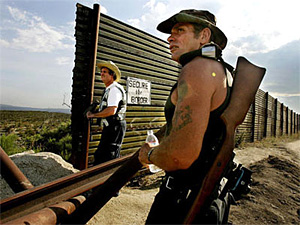 |
 |
 |
 Editorials | Opinions | January 2007 Editorials | Opinions | January 2007  
Getting a Firsthand Look at the Border
 Fort Worth Star-Telegram Fort Worth Star-Telegram


| | Armed California Minutemen volunteers look over the border wall for immigrants trying to cross into the United States in this 2005 file photo made along the U.S.-Mexico Border in Campo California. The controversial group said it was watching parts of the California Border in an attempt to stem the flow of illegal immigration and prevent terrorist suspects from getting into the United States. (AP/Sandy Huffaker) |
Within the context of coming from the East Coast, I think a lot of people see the Southwest border as a wide-open, expansive desert area. Sometime within the next few months, immigration reform will again take center stage - not necessarily a surprise with a Congress controlled by Democrats and a president longing for comprehensive immigration legislation.

The debate will again filter outside the Beltway, fueled and polarized by elected officials, some conservative talk-radio hosts and some Spanish-language media, blogs, ecumenical alliances and economists, among others.

They will spar over militarizing the border and the proposed border wall and whether it would stop illegal immigrants, terrorists and drug traffickers. Opponents of such tactics will say that if the military were placed on the border and the wall were funded, it would be a black eye for the United States - and would never be 100 percent effective.

Many of those participating in that debate get their information from television or the Internet, vetted by people who think like them. Most have never been to the border and don't think they need to go there to better understand the issue.

But if they did, they would comprehend better why the issue is more complicated than just building a wall.

They would see a culture that varies along the border's 2,000 miles, not to mention the intricacies and dangers of the terrain, local economic and diplomatic necessities, bilateral law enforcement efforts and, in Arizona, the impact of the National Guard in interdiction efforts.

During the past 20 years, I have written extensively about people on both sides of the border, from immigrants on one side waiting to cross illegally to Border Patrol agents on the other side. I recently traveled to the Nogales area, in the Border Patrol's Tucson sector.

This region has been ground zero in the immigration debate: immigrants dying in the desert by the hundreds over the past three summers, Minutemen patrolling the area to assist Border Patrol agents, and the deployment of the National Guard to assist the Border Patrol.

Since their arrival during the summer, the rotating 1,500 National Guard troops have built roads along the border, maintained vehicles, constructed vehicle barriers, repaired border fencing and assisted the Border Patrol in identifying illegal crossings.

The guardsmen assigned to entrance identification teams along the Nogales corridor are stationed on hills. They sit in SUVs and notify the Border Patrol when they see an illegal crossing. They are not allowed to confront the crossers.

Since the National Guard has arrived, the number of illegal crossings has decreased and drug seizures have increased in the sector because, Border Patrol officials say, the agents now can concentrate on their primary missions.

For Sgt. Ed Balaban, the liaison between the National Guard and Border Patrol, the experience along the border has been an eye-opener. Other than 11 years in the Navy, most of his life revolved around Brooklyn, where he was born.

'Within the context of coming from the East Coast, I think a lot of people see the Southwest border as a wide-open, expansive desert area,' he said. 'It's a lack of awareness and knowledge of the specific terrain,' which differs 'even when you travel from South Texas to California.'

The Tucson sector stretches for more than 90,000 square miles, from the New Mexico border on the east to about 50 miles west of Yuma, Ariz., and north past Tucson.

In those thousands of square miles are open plains, high grassland, brushland, hills and mountain ranges.

Some of the 2,600 Border Patrol agents assigned to the sector track it via bicycles and high-tech video and infrared cameras, in SUVs and ATVs, by helicopter and horseback. In urban areas within 10 feet of Mexico, many ride in SUVs with windows protected by metal grills.

In Arizona towns such as Douglas and Nogales, agents are on the lookout for tunnels used to smuggle drugs and people. They also watch for people throwing contraband acrossfrom one side to the other.

In Nogales, Border Patrol agents also keep watch on the sewage canal from Nogales, Mexico, to Nogales, Ariz., where waste is treated and returned south. They have video monitors and speakers along the route and frequently tell crossers to go back to Mexico.

Supervisory Border Patrol Agent Gustavo Soto, a former El Paso teacher, said about 90 percent of those coming into the country illegally are doing so for a chance of a better future.

When his National Guard assignment ends next fall, Balaban believes that he will understand the border a little bit better.

'I will come away with a much greater awareness of how much other people want to come to this country because it's still viewed as a land of opportunity,' he said. 'I'll also come away with a greater awareness of our country's vulnerability.' | 
 | |
 |



